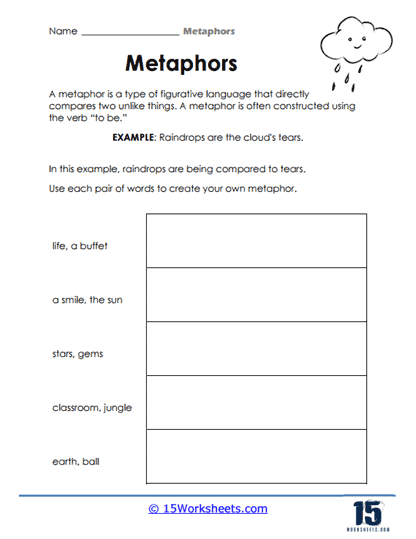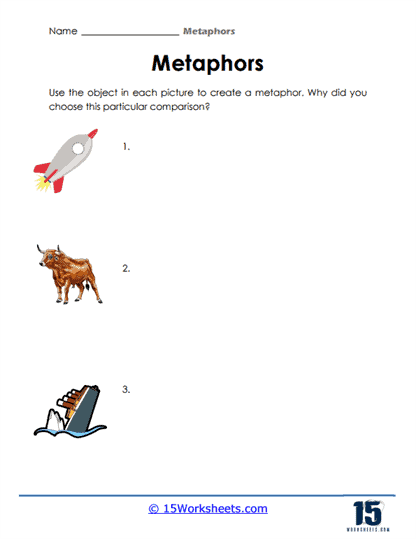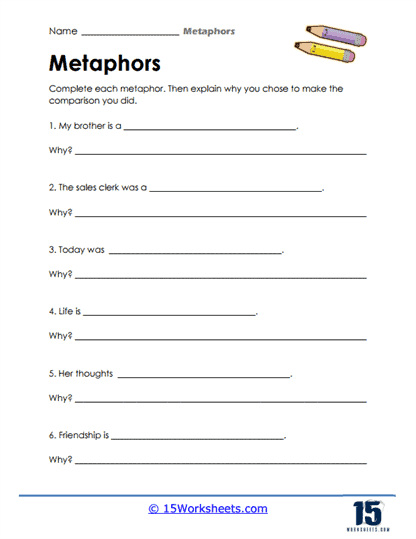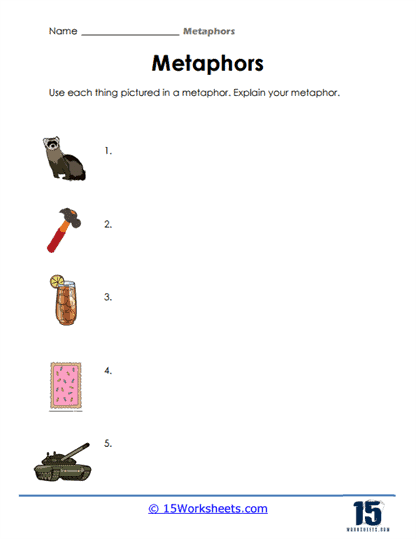Metaphors Worksheets
About These 15 Worksheets
These worksheets will help you understand and practice using metaphors in language. A metaphor is a figure of speech that compares two things by saying one thing is another thing, even though they are not literally the same. It helps us understand something better by comparing it to something else.
To explain metaphors, let’s look at an example – Imagine someone says, “Her voice is music to my ears.” This statement is a metaphor because it compares the person’s voice to music. It doesn’t mean her voice is actually music, but it suggests that her voice brings the same joy and pleasure as listening to music.
Metaphor worksheets provide exercises and activities that help you recognize and use metaphors in sentences or conversations. These worksheets often contain examples of sentences or phrases where you have to identify the metaphors and understand the comparisons being made.
By working on metaphor worksheets, you can:
Identify Metaphors – Metaphor worksheets help you develop the skill of recognizing metaphors in language. By reading sentences or passages, you learn to identify phrases or expressions that compare two things without using “like” or “as.” This skill allows you to appreciate the creative and imaginative use of language in making comparisons.
Understand Figurative Language – Metaphor worksheets allow you to explore the figurative meanings of metaphors. You learn to interpret the implied comparisons and understand the deeper messages or emotions being conveyed. By understanding metaphors, you gain insight into the power of language to communicate complex ideas or emotions in a more vivid and engaging way.
Enhance Writing Skills – By learning about metaphors, you enhance your own writing skills. Metaphors provide a tool to make your writing more expressive and impactful. By practicing metaphors through worksheets, you develop the ability to use this figure of speech in your own writing to convey ideas, create vivid descriptions, or add depth to your storytelling.
Improve Communication – Metaphor worksheets help you become a more effective communicator. Metaphors make language more engaging and memorable, allowing you to express ideas or emotions in a way that resonates with others. By understanding metaphors, you become better equipped to use them in your conversations and writing, making your communication more engaging and persuasive.
Appreciate Creative Language – Metaphor worksheets foster an appreciation for the creative use of language. Metaphors allow us to see the world from different perspectives and make connections between seemingly unrelated things. By exploring metaphors, you develop a deeper understanding and appreciation for the beauty and artistry of language.
Why Do Authors Use Metaphors In Their Work?
Authors use metaphors in their work for several reasons:
Enhancing Descriptions – Metaphors make descriptions more vivid, engaging, and memorable. By comparing one thing to another, authors create a mental image or sensory experience that brings their writing to life. Metaphors help readers visualize and connect with the descriptions on a deeper level.
Adding Depth and Nuance – Metaphors can convey complex ideas, emotions, or experiences in a concise and impactful way. They allow authors to express abstract concepts by relating them to more tangible or familiar objects or experiences. Metaphors add layers of meaning and depth to the writing, encouraging readers to think more deeply about the subject matter.
Creating Emotional Impact – Metaphors evoke emotions and create a powerful emotional impact. By connecting a familiar experience or object with a particular emotion, authors can evoke strong feelings in their readers. Metaphors can heighten the intensity of emotions or capture the essence of a particular mood or atmosphere, making the writing more emotionally resonant.
Stimulating Imagination – Metaphors engage the reader’s imagination and invite them to make connections and draw associations. By presenting comparisons and analogies, metaphors encourage readers to think beyond the literal meanings of words and explore the deeper implications or connections within the text. Metaphors stimulate creativity and invite readers to actively participate in the interpretation of the writing.
Making Complex Ideas Accessible – Metaphors simplify complex or abstract ideas by relating them to something more familiar. They serve as a bridge between unfamiliar or difficult concepts and the reader’s existing knowledge and experiences. Metaphors help readers grasp and understand complex ideas in a more accessible and relatable way.
Creating Memorable Language – Metaphors make language more memorable. They provide unique and imaginative ways of expressing ideas, creating distinctive images or phrases that stick in the reader’s mind. Metaphors contribute to the overall aesthetic quality of the writing and make it more enjoyable and impactful.















